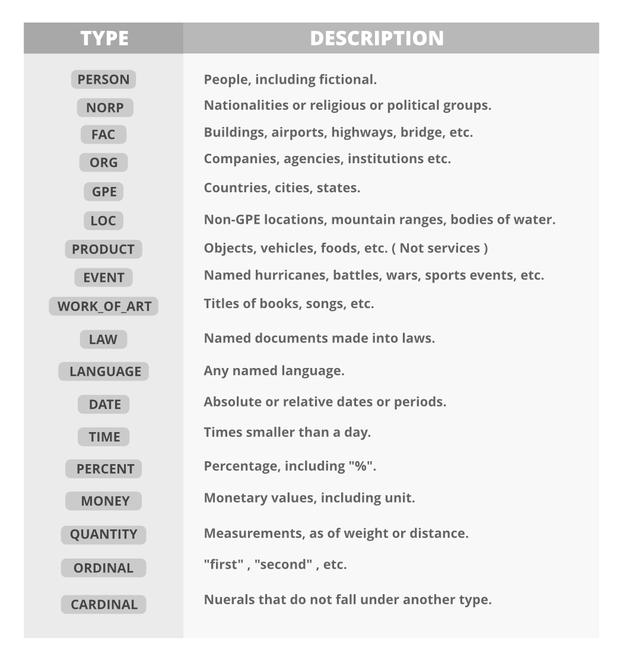命名实体识别
命名实体识别(NER)是最重要的数据预处理任务之一。它涉及识别文本中的关键信息并将其分类为一组预定义的类别。实体基本上是在文本中一直谈论或引用的事物。
NER是NLP的形式。
从本质上讲,NLP 只是一个两步过程,以下是所涉及的两个步骤:
- 从文本中检测实体
- 将它们分为不同的类别
一些类别是 NER 中最重要的架构,例如:
- 人
- 组织
- 地点/地点
其他常见任务包括对以下内容进行分类:
- 约会时间。
- 表达
- 数字测量(金钱、百分比、重量等)
- 电子邮件地址
NE 中的歧义
- 对于一个人来说,类别的定义在直觉上是相当清晰的,但是对于计算机来说,在分类上就有些模糊了。让我们看一些模棱两可的例子:
- 英格兰(组织)赢得 2019 年世界杯 vs 2019 年世界杯发生在英格兰(地点)。
- 华盛顿(位置)是美国的首都 vs 美国的第一任总统是华盛顿(人) 。
NER的方法
- 一种方法是使用不同的机器学习算法训练多类分类模型,但它需要大量标记。除了标注模型,还需要对上下文有深刻的理解,以处理句子的歧义。这使其成为简单机器学习的一项具有挑战性的任务 /
- 另一种方法是由 NLP Speech Tagger 和 NLTK 实现的条件随机字段。它是一种概率模型,可用于对单词等顺序数据进行建模。 CRF 可以捕捉对句子上下文的深刻理解。在这个模型中,输入


- 基于深度学习的 NER:深度学习 NER 比以前的方法准确得多,因为它能够组合单词。这是因为它使用了一种叫做词嵌入的方法,能够理解各种词之间的语义和句法关系。它还能够自动学习分析特定主题以及高级单词。这使得深度学习 NER 适用于执行多项任务。深度学习本身可以完成大部分重复性工作,因此研究人员可以更有效地利用他们的时间。
执行
- 在这个实现中,我们将使用两个不同的框架执行命名实体识别:Spacy 和 NLTK。此代码可以在 colab 上运行,但用于可视化目的。我推荐当地的环境。我们可以使用 pip install 安装以下框架
- 首先,我们使用 Spacy 执行命名实体识别。
Python3
# command to run before code
! pip install spacy
! pip install nltk
! python -m spacy download en_core_web_sm
# imports and load spacy english language package
import spacy
from spacy import displacy
from spacy import tokenizer
nlp = spacy.load('en_core_web_sm')
#Load the text and process it
# I copied the text from python wiki
text =("Python is an interpreted, high-level and general-purpose programming language
"Pythons design philosophy emphasizes code readability with"
"its notable use of significant indentation."
"Its language constructs and object-oriented approachaim to"
"help programmers write clear and"
"logical code for small and large-scale projects")
# text2 = # copy the paragrphs from https://www.python.org/doc/essays/
doc = nlp(text)
#doc2 = nlp(text2)
sentences = list(doc.sents)
print(sentences)
# tokenization
for token in doc:
print(token.text)
# print entities
ents = [(e.text, e.start_char, e.end_char, e.label_) for e in doc.ents]
print(ents)
# now we use displaycy function on doc2
displacy.render(doc, style='ent', jupyter=True)Python3
# import modules and download packages
import nltk
nltk.download('words')
nltk.download('punkt')
nltk.download('maxent_ne_chunker')
nltk.download('averaged_perceptron_tagger')
nltk.download('state_union')
from nltk.corpus import state_union
from nltk.tokenize import PunktSentenceTokenizer
# process the text and print Named entities
# tokenization
train_text = state_union.raw()
sample_text = state_union.raw("2006-GWBush.txt")
custom_sent_tokenizer = PunktSentenceTokenizer(train_text)
tokenized = custom_sent_tokenizer.tokenize(sample_text)
# function
def get_named _entity():
try:
for i in tokenized:
words = nltk.word_tokenize(i)
tagged = nltk.pos_tag(words)
namedEnt = nltk.ne_chunk(tagged, binary=False)
namedEnt.draw()
except:
pass
get_named_entity()[Python is an interpreted, high-level and general-purpose programming language.,
Pythons design philosophy emphasizes code readability with its notable use of significant indentation.,
Its language constructs and object-oriented approachaim to help programmers write clear, logical code for small and large-scale projects]
# tokens
Python
is
an
interpreted
,
high
-
level
and
general
-
purpose
programming
language
.
Pythons
design
philosophy
emphasizes
code
readability
with
its
notable
use
of
significant
indentation
.
Its
language
constructs
and
object
-
oriented
approachaim
to
help
programmers
write
clear
,
logical
code
for
small
and
large
-
scale
projects
# named entity
[('Python', 0, 6, 'ORG')]
#here ORG stands for Organization
doc2 上的 Spacy 实体标签
- 以下是 spacy 实体标签的列表及其含义:

Spacy 命名实体识别标签
- 现在我们在 NLTK 上执行命名实体识别任务。
蟒蛇3
# import modules and download packages
import nltk
nltk.download('words')
nltk.download('punkt')
nltk.download('maxent_ne_chunker')
nltk.download('averaged_perceptron_tagger')
nltk.download('state_union')
from nltk.corpus import state_union
from nltk.tokenize import PunktSentenceTokenizer
# process the text and print Named entities
# tokenization
train_text = state_union.raw()
sample_text = state_union.raw("2006-GWBush.txt")
custom_sent_tokenizer = PunktSentenceTokenizer(train_text)
tokenized = custom_sent_tokenizer.tokenize(sample_text)
# function
def get_named _entity():
try:
for i in tokenized:
words = nltk.word_tokenize(i)
tagged = nltk.pos_tag(words)
namedEnt = nltk.ne_chunk(tagged, binary=False)
namedEnt.draw()
except:
pass
get_named_entity()

NER的一个句子示例